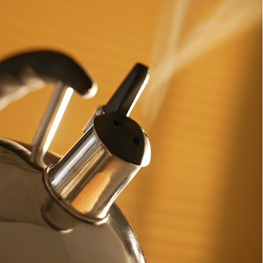Learning neuroscience is certainly not on every parent's agenda. But what if a little insight into your child's brain could defuse at least one tantrum a day? Dr. Dan Siegel and Mary Hartzell, authors of Parenting from the Inside Out, developed a simple demonstration to help parents understand where kids' outbursts come from so we can respond effectively.
 Brain in the Palm of Your Hand
Brain in the Palm of Your Hand
Make a fist with your thumb tucked inside your fingers. This is a model of your brain; your fist is the brain and your wrist and forearm is the spinal cord.
Your thumb, tucked in the middle of your fist, is the midbrain. This is where our emotions and memories are created and processed, as well as where the fight-or-flight reflex is triggered. The midbrain is our “emotional brain.”
The back of your hand and fingers, encasing everything, is the cerebral cortex. This is where higher functioning occurs. This part of our brain allows us to think logically, act with kindness and empathy, and it houses our reasoning and problem-solving abilities. The cortex is our “rational brain.”
The brain is set up to communicate with itself. It sends messages from section to section about what our bodies are feeling and needing. So, when a child screams, “Noooo!” and lashes out to hit because they are angry, a parent's brain interprets this data as, “Hmm, I don't like this, and I need to be treated differently.” Only we don't always react so calmly, right?
Take another look at your brain-fist. See where your fingernails are? This is the logic and reasoning part of the brain that kicks into gear when we have a problem to solve. But sometimes the emotional brain (thumb) and the rational brain (fingers) don't communicate so well. The emotions of the midbrain are simply too overwhelming, our fight-or-flight reflex triggers, and we 'flip our lids.' Now make all four of your fingers stand straight up. Flip.
See your fingertips now? See how far away from the midbrain they are? When we 'flip our lids,' our rational brains have a very poor connection with our emotional brains. Our feelings are intense, and we're not able to access the logical, problem-solving part of our brain. In order to restore our rational brain to its coherent state, we need to calm our anger and ease our fears (close fingers over thumb again).
Of course, our brains don't actually change shape like this, but this simple demonstration is a valuable tool in understanding how they function during emotionally charged situations. Both children and adults experience flipped lids. But as the human brain isn't fully mature (all parts communicating effectively) until the mid-twenties, children flip their lids much more often. They need a lot more help 're-connecting' the rational brain with the emotional brain - that is, calming down - and learning how to respond to strong emotions.
Parenting Through Flipped Lids
So, what can parents do when emotions run strong? Dr. Jane Nelsen, author of Positive Discipline, offers a few tools that help during 'flipped lid' moments:
Hugs. When your child flips their lid, a hug may be the last thing you want to offer. But it might just be the thing they need most. The mirror neurons in your child's brain sense the emotional state of the people around them and influence their reactions. When their brain picks up on the loving composure in a hug, its chemistry begins to return to a calm state; their 'flipped lid' begins to close.
Positive time-out. This is perfect for when either you or your child has a flipped lid. Before reacting to your misbehaving child or your favorite collectible that mysteriously broke, take a few minutes alone to calm down and restore your brain chemistry. The problem - the one that triggered your flipped lid - will still be there when you're feeling better. Communication will go much more smoothly when you have access to your rational brain. With time and practice, you can also teach your child how to take a positive time-out for him or herself when they're upset and needs to calm down.
Focus on solutions. This is for when you're about to flip your lid, or have just calmed down after one. Yes, there's a huge mess on the floor. Yes, your two-year-old is bothering his older (and now very annoyed) sibling again. Yes, someone lost an important item again or someone else is dawdling to get ready… again. But rather than get mad and yell (again), focus on practical solutions to these problems. Instead of thinking, “What can I do to you so that you’ll learn?” think, “What can I do to help you succeed with this? What solutions can we come up with?”
Apologize. For those times when you do flip your lid, a sincere apology helps to emotionally reconnect you and your child. Tell your child, “I'm sorry I yelled. I'm sure that must have hurt your feelings. You were upset, and you needed to feel better, not worse. I'd love to hear your ideas on how to fix this.”
Flipping your lid, while not ideal or sometimes even avoidable, does provide an opportunity to model and teach some valuable skills to our children: cooling off, self-control, problem-solving and, probably most importantly, emotional recovery and reconnection after a hurtful situation.
Kelly is a freelance writer and a certified positive discipline educator.
Calgary’s Child Magazine © 2024 Calgary’s Child